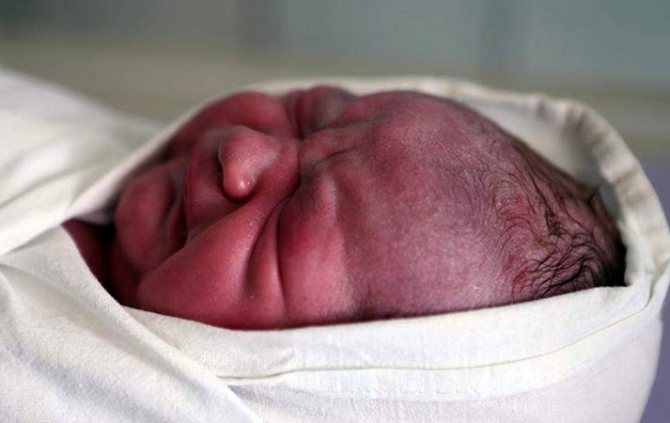What does a newborn baby look like?
Almost every baby emerges from the mother's birth canal with a pale blue skin color. He takes his first breath into his lungs, begins to breathe, and his body turns pink. Although the mother will not be able to see the color of her baby’s skin in the first minutes, because it is all covered with white lubricant, which protected it while in the womb. Medical workers rinse the baby, conduct an examination and evaluate his condition using the Apgar scale. Some time after birth, the baby's legs and arms may be blue, and there are situations when the entire skin has a bluish or even purple tint for several days. Experts believe that this may be a consequence of oxygen starvation. A newborn with bluish skin color immediately falls under the special control of doctors until the color of his skin returns to normal.
Healthy baby skin
Almost all babies are born pale blue. After the child begins to breathe on his own, and not with the help of the umbilical cord, the baby’s body turns pink and he acquires his usual skin color. The baby's skin is elastic, soft and velvety to the touch.
At birth, the baby's skin is covered with a special lubricant, a white coating that protects the skin from getting wet during life in the mother's womb. Once the baby is born, the lubricant can be wiped off with diapers. It is necessary to carefully remove it in the folds so that the baby’s skin does not rot.
Read also:
A pacifier is a relic of the past or a breastfed baby's best friend
First examination of the child
The first medical examination of the baby is carried out by a doctor immediately after the baby is born. The pediatrician not only checks that everything is okay with the newborn, but also performs the necessary procedures: clears the airways of accumulated mucus, clamps and cuts the umbilical cord, treats it, and administers eye drops to prevent the entry of harmful bacteria. In addition, the doctor measures the baby's height and head circumference, weighs him, counts his fingers and toes, and evaluates the appearance of all parts of the body.
Apgar score
The child's physical condition is assessed using the Apgar scale. This is a mandatory test that checks the development of every newborn. The scale owes its name to anesthesiologist Virginia Apgar, who proposed the use of this system.
To assess the condition of a newborn using the Apgar scale, the following parameters are checked: pulse, muscle tone, breathing, reflexes, skin color. There are 5 indicators in total. Each of them is scored 0-2 points. Thus, the maximum a child can score is 10 points, and this will be the ideal result.
However, most healthy babies score between 7 and 9 Apgar scores. And that's absolutely normal. By the way, this system does not evaluate the child’s mental abilities, but only the physical condition, so there is no need to attach great importance to the fact that the baby did not score the highest number of points.

Why can your baby's skin have a blue tint?
Many mothers are interested in why the child was born blue. According to experts, in most cases, bluish skin color is not a pathology. Often, as soon as the baby begins to breathe on his own, the skin acquires a normal pinkish tint.
If the cyanosis does not go away for a long time, then this indicates oxygen starvation that the baby experienced while in the mother’s womb. The cause of a bluish tint to the face may be entanglement in the umbilical cord, anemia, birth trauma and other pathologies.
Modern diagnostic methods make it possible to identify all possible abnormalities in the first hours of a baby’s life, after which doctors begin to take measures to help the baby as soon as possible. Don't panic prematurely if your baby is born blue. The causes and consequences can be very different, but according to statistics, most often the cyanosis goes away after a few days.

Umbilical cord entanglement
Entwining the fetus with the umbilical cord occurs quite often in medical practice. According to statistics, it occurs in 20 - 25% of women. The main reason for entanglement is excessive activity of the fetus, which can be caused by hypoxia or a large production of adrenaline in the mother’s blood (which is often associated with stress).
The entanglement can be seen by an ultrasound specialist during a routine examination. However, do not panic ahead of time. The fetus is in constant motion, which is why it can wrap itself around the umbilical cord and come out of it several times a day. The most dangerous is considered to be a double entanglement of the umbilical cord around the neck, the consequence of which can be asphyxia. Choking can have dire consequences, including even mental and physical retardation of the child. Experts believe that entanglement is practically not dangerous if the umbilical cord is long. But if it is short, this is already a cause for concern.
It is worth noting that often the entanglement is false. That is, an ultrasound specialist may make a mistake during an examination and make a diagnosis of “umbilical cord entanglement” even when there is actually none.

Causes of hypoxia
- Pathological changes in the placenta and its detachment.
- The umbilical cord is wrapped around the baby's neck . This predisposing factor can be diagnosed during a routine ultrasound. If entanglement is observed during the examination, the issue of delivery through surgery is decided.
- Diseases of the cardiovascular system in a pregnant woman. Especially often, the cause of the development of pathology is heart disease.
- Gestosis of the 2nd half of pregnancy . A dangerous phenomenon that is manifested by increased blood pressure, edema and the appearance of protein in the urine.
- High blood pressure.
- Bleeding during childbirth.
- Threat of premature birth.
- Alcohol abuse during pregnancy.
- Drug addiction.
- Taking certain medications . These include some groups of antibiotics and hormonal drugs.
- Genetic abnormalities in fetal development . For example, Down syndrome.
- Abdominal injuries.
- Diabetes mellitus in a pregnant woman.
- Diseases of the respiratory system during pregnancy.
- Acute infectious diseases suffered during pregnancy . These include influenza, measles, rubella and chickenpox. These infections often complicate pregnancy by fetal hypoxia and other pathologies.
- Intrauterine infections . These include pathogens of sexually transmitted infections and opportunistic microorganisms (Escherichia coli, Klebsiella).
- Insufficient exposure to fresh air during pregnancy. To a lesser extent influence the development of hypoxia. But nevertheless, staying in the fresh air reduces the risk of hypoxia several times.

Jaundice of newborns
Undoubtedly, all mothers want to know why the baby was born blue. However, the bluish color of the skin may disappear without a trace on the very first day. The yellowish tint of the baby's skin causes considerable concern among parents. This is due to the concept of infant jaundice, which occurs due to the increased content of bile pigment in the body.
Experts note that the yellow tint is noticeable not only on the baby’s skin, even the whites of the eyes turn yellow. The cause of jaundice is increased bilirubin. The small body tries to get rid of the excess of this component as quickly as possible: it enters the liver, mixes with the enzyme and is excreted in the urine. However, sometimes the liver does not have time to cope with the heavy load placed on it, which is why the jaundice intensifies. Normally, the yellow tint to the skin should disappear within 2 weeks after the baby is born.

If jaundice is severe or only worsens over time, drug treatment and various procedures are prescribed. Phototherapy is very effective. In some cases, jaundice is pathogenic. It is important to correctly determine the cause of its occurrence as soon as possible, which will avoid sad consequences.
Advice for young mothers
The baby's skin, especially in the first months of life, is very vulnerable. There is a high risk of developing all kinds of infections on the baby’s body. In order to avoid infection, it is necessary to carefully and carefully care for the skin of a newborn.
If you are concerned about the condition of your baby’s skin and you are not sure about the safety of the symptoms, do not waste time, immediately seek advice from a specialist. The future health of the baby often depends on this.
Read also:
How to wean your baby off night feedings
Follow all the pediatrician’s recommendations and do not use questionable hygiene products to care for your baby. Today, experts recommend stopping the use of baby powders and oils. These products can only be used as prescribed by a doctor. Follow the rules of hygiene and your baby will be healthy.
Norm of bilirubin by day in newborns
A newborn baby's blood is taken for analysis. This is necessary in order to keep all the most important indicators under control. The doctor pays special attention to the level of bilirubin in the blood.
Bilirubin norms in infants:
- day from birth – up to 85 µmol/l;
- 2 days from birth – up to 180 µmol/l;
- 3 -5 days – maximum value 256 µmol/l;
- 6 - 7 days - maximum value 145 µmol/l;
- 8 - 9 days - maximum value 110 µmol/l;
- 10 - 11 days - maximum value 80 µmol/l;
- 12 - 13 days - maximum value 45 µmol/l;
The older the baby, the lower the levels of bilirubin in the blood become. At the age of 2 weeks and older, the maximum value may be 20.5 µmol/l.

What causes cyanosis of hands and feet?
Peripheral cyanosis is a condition in which the tips of the fingers and toes turn blue due to insufficient blood circulation. Cold, circulation problems and tight jewelry are common causes of peripheral cyanosis.
It is worth noting that cyanosis comes from the Latin “cyan”, which means blue-green color.
INFORMATIVE:
Is your ear blocked or hurt?
Symptoms of peripheral cyanosis
Individuals with peripheral cyanosis may experience the following symptoms:
- the tips of your fingers or toes turn blue-green;
- affected areas are cold to the touch;
- blue skin regains color after warming up.
Causes of peripheral cyanosis
All organs and tissues in the body require oxygen to perform their functions. The human body absorbs oxygen from the air it breathes. The blood contains a protein - hemoglobin, which delivers oxygen to every cell of the body. When oxygen transport is difficult, cyanosis may occur.
Most often, cyanosis affects the extremities - the tips of the fingers and toes. This is due to the distance of these parts of the body from the heart.
Causes of cyanosis
- Certain medical interventions that may interfere with the transport of oxygen to tissues.
- Genetic abnormalities of hemoglobin - impaired ability to bind with oxygen and transfer it to cells.
- Raynaud's syndrome is a condition in which the fingertips become painful and turn blue or white from cold. This occurs when blood vessels narrow, preventing blood from flowing into the extremities.
- Low blood pressure. Lack of sufficient pressure leads to the fact that insufficient blood enters the limbs. Low blood pressure is also called hypotension.
- Hypothermia. In this case, the body temperature drops to dangerously low levels. Hypothermia is a medical emergency.
- Problems with veins or arteries also lead to obstructed blood flow to the extremities. Possible causes include venous insufficiency, peripheral vascular disease, or vascular occlusion.
- Heart failure. Blood does not circulate through the body with sufficient force.
- Problems with the lymphatic system. Lymphatic dysfunction is a condition in which lymph fluid stagnates, leading to swelling and poor circulation.
- Deep vein thrombosis. Blood clots clog the veins and interfere with proper blood circulation.
- Hypovolemic shock. In this condition, the blood supply to the organs increases, and the skin decreases.
How does peripheral cyanosis differ from central cyanosis?
The key difference between peripheral and central cyanosis is the location of their action.
Peripheral cyanosis most often affects the extremities. The action can be either unilateral or symmetrical.
Central cyanosis affects the organs. There is a bluish discoloration of the central part of the body, lips and tongue. Warming the affected areas does not improve the condition.
Central and peripheral cyanosis have similar causes, which include problems with the heart, blood, lungs and nervous system.
How to diagnose?
Doctors diagnose peripheral cyanosis through a combination of physical tests, body scans, and blood tests. These tests can identify the cause of low oxygen levels in the body. It is extremely important to undergo all necessary tests recommended by your doctor.
How to treat?
Treatment for peripheral cyanosis depends on the cause of its occurrence. Often therapy consists of prescribing medications to improve the functioning of the heart and lungs. The goal is to improve blood flow and oxygen supply to organs and tissues. In some cases, oxygen therapy is used to restore normal oxygen levels.
Doctors recommend stopping taking any medications that restrict blood flow (beta blockers, birth control, and some antihistamines) and making lifestyle changes such as smoking and caffeine.
When should you see a doctor?
In most cases, peripheral cyanosis is considered as a concomitant disease. The causes of its occurrence can be life-threatening. Anyone experiencing the following symptoms should seek medical attention immediately:
- labored breathing;
- chest pain;
- profuse sweating;
- sudden pain or numbness in the limbs;
- difficulty concentrating or confusion;
- fever symptoms.
Peripheral cyanosis in infants
Peripheral cyanosis can occur in individuals of all age groups, including newborns. An estimated 4.3% of newborns develop cyanosis, which requires oxygen therapy. There can be many reasons for cyanosis in babies: problems with the heart, uneven system, lungs, abnormal cellular dysfunction.
It can be difficult to detect peripheral cyanosis in infants, especially newborns. A symptom such as jaundice masks the blue-green color of the skin.
Peripheral cyanosis is not usually considered a medical emergency. However, central cyanosis signals serious problems and requires immediate medical attention.
What is the treatment prognosis?
The prospect of treatment depends on the cause of peripheral cyanosis. If the symptoms of cyanosis do not disappear after warming up the extremities, you should consult a doctor.
Timely diagnosis can correctly determine the cause of the disease, which will ensure timely treatment at an early stage.
Based on materials from www.medicalnewstoday.com
